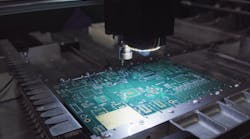This article is part of the TechXchange: PCB Tools and Technology.
Many manufacturers still use the standard FR-4 material for their rigid boards because FR-4 materials are cost-efficient and highly suitable for a large variety of applications. However, a new technological advance has been making waves: polyimide PCB materials.
What are Polyimide PCB Materials?
The term polyimide combines two words—poly and imide. Poly refers to polymers, the word imide represents “progressive imide monomers.”
Polymers are a result of synthetic or natural formation. In terms of printed circuit boards, the polymer materials are mostly synthetic. Several chemicals with amide bonds are responsible for producing the synthetic polyimides necessary in PCB fabrication. Polymerization is the process of manufacturing polyimides. Production of PCB materials is the final outcome of the polymerizing process.
Difference Between Polyimide and FR-4 PCB Materials
FR-4 is a substrate for a PCB. The number 4 refers to the grade of the material. FR-4 is a flame-resistant material standardized by the National Electrical Manufacturers Association (NEMA). Therefore, when any material is applied with the term FR-4, it means that the material is compliant to the UL94V-0 standard.
Manufacturers use laminated fiberglass to produce most FR-4 materials. They melt raw glass and convert them to filaments of fiber yarn, and then weave them into fiberglass cloth of various types. They coat the cloth with a coupling agent and a resin that enhances its adhesion. After completing the adhesion process, they bond the board with a copper foil. This copper clad is the base material for manufacturing PCBs.
The epoxy resin, glass cloth, and laminated copper in FR-4 circuit boards make these boards rigid. In contrast, polyimide materials are more flexible, lighter, and more durable than FR-4 materials. Polyimide materials also have better heat and chemical resistance as compared to FR-4 materials. Although polyimide PCBs are more expensive than FR-4 boards, better features and properties of the former offset the higher expense.
Types of Polyimide PCB Materials
Manufacturers are able to control the amount of flexibility in polyimide materials during fabrication. They can produce highly flexible as well as rigid polyimide boards. Types of polyimide materials include:
Low-Flow Polyimides
The stiffness offered by low-flow polyimide materials is necessary for fabricating rigid PCB circuits. This rigidity gives the boards substantial stability in adverse conditions of temperature variation and mechanical vibrations. Low-flow polyimides are highly stable even in conditions where standard FR-4 circuits fail.
Second-Generation Pure Polyimides
Pure polyimides are second-generation materials. They’re not flame-retardant—they don’t contain additional retardants like bromides. For this reason, pure polyimides are stable and flexible, suiting them for use in various electrical devices as polyimide flexible PCBs that offer high resilience against temperature variations.
Third-Generation Polyimides
These advanced versions of second-generation polyimides contain additives that make them flame-retardant. However, this feature somewhat reduces their thermal stability. Production cost for third-generation polyimides is quite low, though.
Filled Polyimides
Filled polyimides are typically used to fabricate multilayered boards. They contain many filler materials to prevent shrinkage, which increases the longevity of the circuit boards and reduces their vulnerability to cracks when drilling or curing.
Advantages of Polyimide Materials
There are multiple benefits to using polyimide materials for PCBs:
- Improved thermal stability
- Increased durability
- Improved tensile strength
- Greater flexibility and stability
- Higher resistance to chemicals
Conclusion
Electronic devices often require massive safety measures before their release to the market. This means PCBs that are not only safe, but also durable. That’s why more engineers are turning to polyimide PCBs for use in consumer, industrial, and military grade electronic products.
